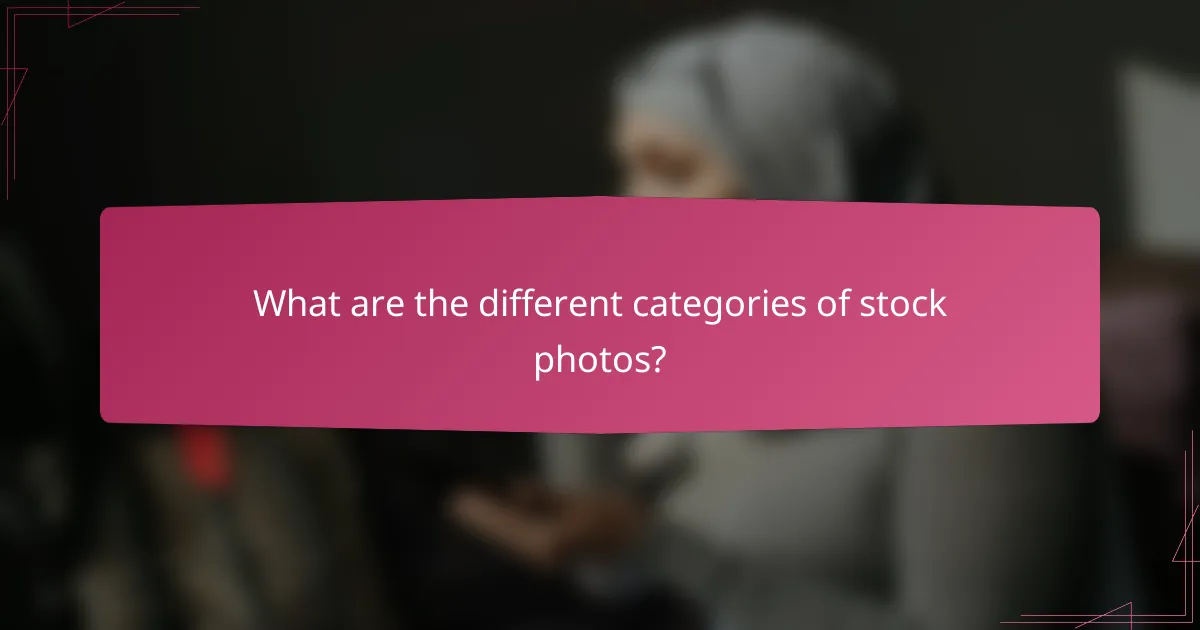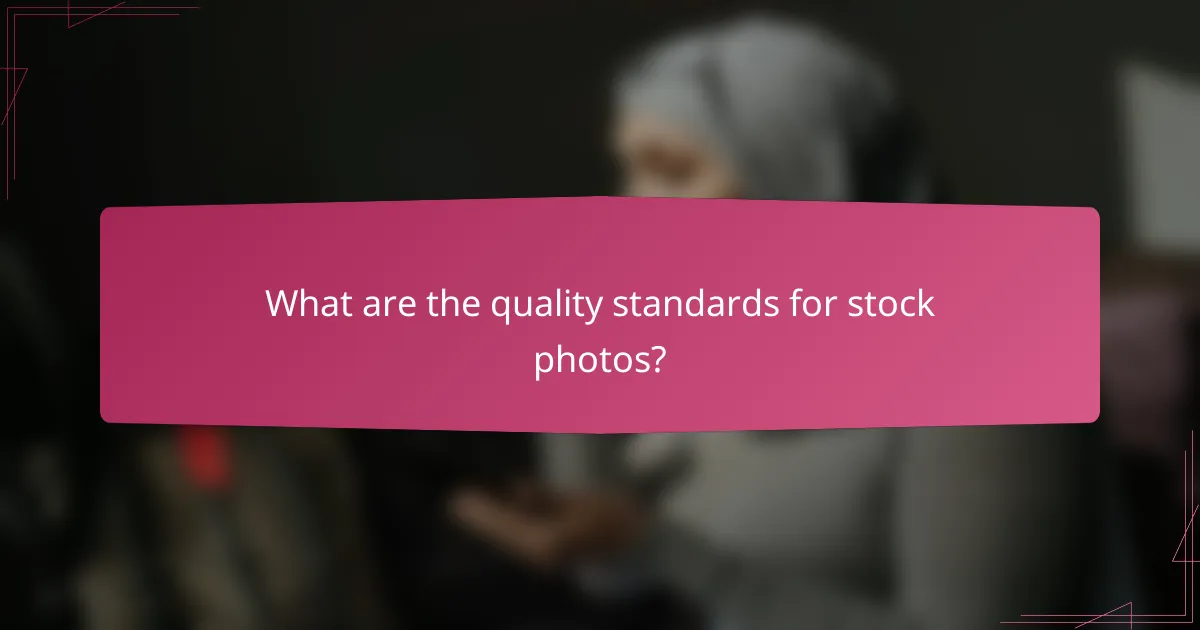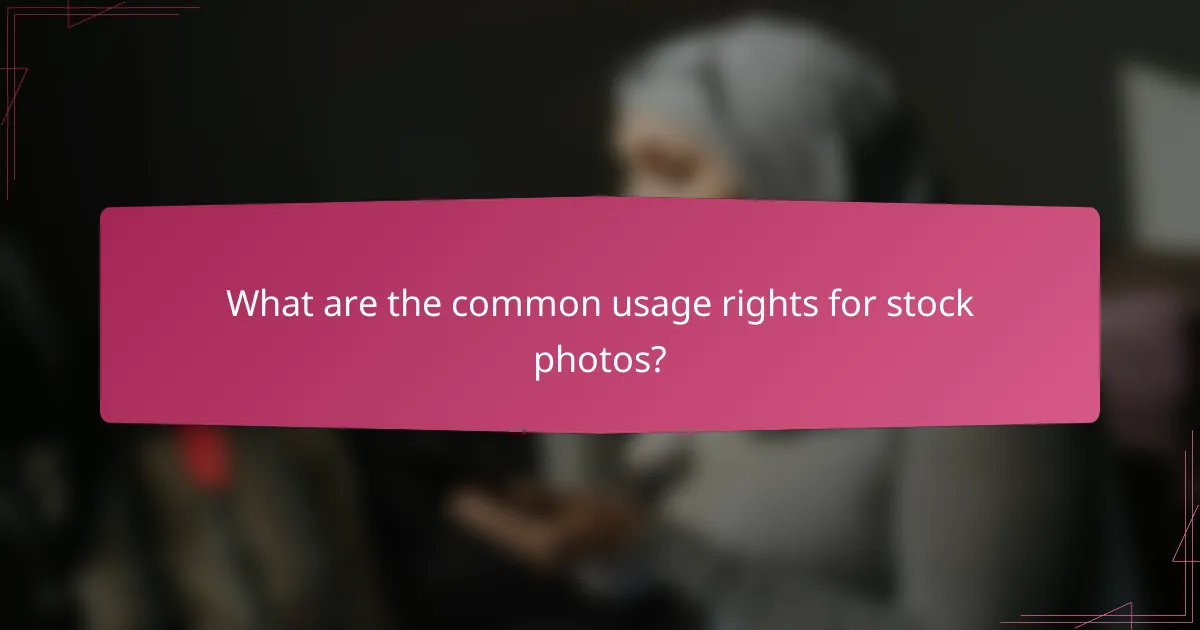Stock photos are essential resources for digital projects, offering a diverse range of high-quality images across various categories. When selecting stock photos, it’s crucial to understand licensing agreements and usage rights to ensure compliance and suitability for your brand. Popular platforms like Shutterstock, Adobe Stock, and Unsplash provide flexible options to meet different needs and budgets.

What are the best stock photo sources for digital products?
The best stock photo sources for digital products include platforms that offer a wide variety of high-quality images, flexible licensing options, and user-friendly interfaces. Popular choices like Shutterstock, Adobe Stock, Getty Images, iStock, and Unsplash cater to different needs and budgets, making them suitable for various digital projects.
Shutterstock
Shutterstock is a leading stock photo provider known for its extensive library of over 300 million images. It offers subscription plans and on-demand image packs, allowing users to choose based on their usage frequency and budget. The platform also provides advanced search filters to help users find specific images quickly.
When using Shutterstock, consider the licensing options, as they vary from standard to enhanced rights. Enhanced licenses are necessary for high-visibility projects, such as merchandise or advertising, where broader usage is required.
Adobe Stock
Adobe Stock integrates seamlessly with Adobe Creative Cloud applications, making it a convenient choice for designers and creatives. It offers millions of high-quality images, videos, and templates, with flexible subscription plans that cater to different needs.
Users can purchase images on a pay-per-image basis or opt for a monthly subscription. Adobe Stock also provides a free trial, allowing potential users to explore its offerings before committing financially.
Getty Images
Getty Images is renowned for its premium quality and exclusive content, including editorial images and celebrity photos. It is often the go-to source for high-profile projects requiring unique visuals. Getty Images operates on a licensing model that includes rights-managed and royalty-free options.
While Getty Images can be more expensive than other platforms, the quality and exclusivity may justify the cost for certain projects. Always review the licensing terms to ensure compliance with usage rights.
iStock
iStock, a subsidiary of Getty Images, offers a more affordable alternative with a vast library of millions of images. It provides both subscription and credit-based purchasing options, catering to users with varying budgets. iStock’s pricing is generally lower than Getty Images, making it accessible for small businesses and freelancers.
iStock also features a selection of exclusive content, which can be beneficial for users seeking unique images without the higher price tag associated with Getty Images.
Unsplash
Unsplash is a popular platform for free high-resolution images contributed by photographers worldwide. It operates under a generous license that allows users to download and use images without attribution, although crediting the photographer is encouraged.
While Unsplash is an excellent resource for budget-conscious projects, the selection may not be as extensive as paid platforms. Users should also be aware that since images are free, they may be used by many others, which can affect uniqueness.

How to choose stock photos for commercial use?
Choosing stock photos for commercial use involves understanding licensing agreements and usage rights to ensure legal compliance and appropriate application. Prioritize high-quality images that align with your brand while adhering to the specific terms set by the stock photo provider.
Check licensing agreements
Licensing agreements dictate how you can use stock photos, so it’s essential to read them carefully before making a selection. Common types of licenses include royalty-free, rights-managed, and extended licenses, each with different restrictions and costs.
For instance, a royalty-free license allows you to use the image multiple times without additional fees, while a rights-managed license may limit usage to specific projects or timeframes. Always verify whether the license covers commercial use, especially if you’re planning to use the images in advertising or promotional materials.
Understand usage rights
Usage rights specify how and where you can use the stock photos. These rights can vary significantly based on the license type, so it’s crucial to ensure that your intended use aligns with the granted rights. For example, some images may be restricted from use in merchandise or resale.
Additionally, be aware of model and property releases, which are necessary if the photo features identifiable people or private property. Without these releases, you may face legal issues if you use the image in a way that could imply endorsement or ownership.

What are the different categories of stock photos?
Stock photos are typically organized into various categories to help users find the images they need quickly. Common categories include business and finance, nature and landscapes, people and lifestyle, food and drink, and technology, each serving distinct purposes and audiences.
Business and finance
Business and finance stock photos focus on themes such as corporate environments, teamwork, and financial growth. These images often feature professionals in office settings, charts, and graphs to convey success and productivity.
When selecting business stock photos, consider the context in which they will be used. For instance, images depicting diversity in the workplace can enhance marketing materials aimed at a broader audience.
Nature and landscapes
Nature and landscapes stock photos capture the beauty of the natural world, including forests, mountains, oceans, and wildlife. These images are ideal for projects related to travel, environmental awareness, and outdoor activities.
To make the most of nature stock photos, choose images that evoke specific emotions or themes, such as tranquility or adventure. High-resolution images can enhance the visual appeal of websites, brochures, and presentations.
People and lifestyle
People and lifestyle stock photos showcase individuals and groups engaged in various activities, reflecting everyday life and cultural diversity. These images often depict family interactions, leisure activities, and urban living.
When using lifestyle stock photos, aim for authenticity. Images that resonate with real-life experiences tend to connect better with audiences, making them more effective for marketing and social media campaigns.
Food and drink
Food and drink stock photos highlight culinary delights, from gourmet dishes to casual snacks. These images are essential for restaurants, food blogs, and culinary publications seeking to entice viewers.
To effectively use food stock photos, focus on vibrant colors and appealing presentations. Consider seasonal themes or cultural dishes to attract specific target markets, enhancing engagement and interest.
Technology
Technology stock photos depict modern innovations, gadgets, and digital interactions. These images are crucial for tech companies, educational materials, and websites focusing on advancements in technology.
When selecting technology stock photos, ensure they reflect current trends and user experiences. Images that illustrate concepts like remote work or smart devices can enhance relevance and relatability in your projects.

What are the quality standards for stock photos?
Quality standards for stock photos focus on technical specifications and aesthetic appeal. High-quality stock images typically meet specific resolution, composition, and editing criteria to ensure they are suitable for commercial use.
Resolution requirements
Resolution is crucial for stock photos, as it determines the clarity and detail of the image. Most stock photo platforms require images to have a minimum resolution of 300 DPI (dots per inch) for print and 72 DPI for web use. This ensures that images look sharp and professional across various media.
For practical purposes, stock photos should ideally be at least 3000 pixels on the shortest side, allowing for flexibility in cropping and resizing without losing quality. Always check the specific requirements of the platform you are using, as they may vary.
Image composition
Image composition involves the arrangement of visual elements within the frame. Strong compositions often follow established principles, such as the rule of thirds, leading lines, and balanced elements, which help create visually appealing images. A well-composed photo draws the viewer’s eye and communicates the intended message effectively.
When selecting stock photos, look for images that have clear focal points and appropriate negative space, making them versatile for various uses, such as advertisements or social media posts. Avoid overly cluttered images that may distract from the main subject.
Editing and post-processing
Editing and post-processing enhance the quality of stock photos by adjusting color balance, contrast, and sharpness. High-quality stock images often undergo professional editing to ensure they meet industry standards. This includes correcting exposure issues and removing any distracting elements.
When using stock photos, be mindful of the editing style that aligns with your brand. Consistency in editing can create a cohesive visual identity across your projects. Additionally, avoid excessive filters or effects that may detract from the image’s natural appeal.

What are the common usage rights for stock photos?
Common usage rights for stock photos include various licensing options that dictate how images can be used. Understanding these rights is essential for selecting the right images for your projects while avoiding legal issues.
Royalty-free
Royalty-free licenses allow users to pay a one-time fee to use the image without paying additional royalties for each use. This type of license typically grants broad usage rights, including commercial applications, but may have restrictions on resale or redistribution.
When using royalty-free images, check the specific terms as they can vary by provider. For example, some may limit the number of copies you can distribute or require attribution.
Rights-managed
Rights-managed licenses are more restrictive and require users to negotiate specific terms for each use of the image. This includes factors such as the duration of use, geographic distribution, and the type of media in which the image will appear.
While rights-managed images can be more expensive, they often provide exclusivity, meaning no one else can use the same image for the agreed-upon period. This is beneficial for brands looking to maintain a unique visual identity.
Editorial use only
Images labeled for editorial use only can be used in non-commercial contexts, such as news articles, blogs, or educational materials. These images cannot be used for promotional or advertising purposes.
When selecting editorial images, ensure they are relevant to the content and comply with any attribution requirements. Misusing these images in commercial contexts can lead to legal repercussions.
